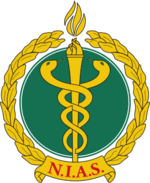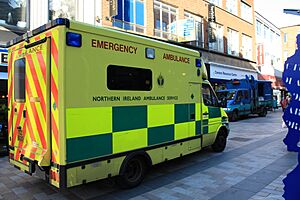Northern Ireland Ambulance Service facts for kids
Quick facts for kids Northern Ireland Ambulance Service Health and Social Care Trust |
|
|---|---|
 |
|
| Established | 1 April 1995 |
| Headquarters | Ambulance Headquarters, Knockbracken Healthcare Park, Belfast |
| Region served | Northern Ireland |
| Area size | 5,345 square miles (13,840 km2) |
| Population | 1.9 million |
| Establishments | 46 stations and deployment points |
| Chair | Michele Larmour |
| Chief executive | Maxine Paterson (Interim) |
| Staff | 1,300 (2018/19) |
The Northern Ireland Ambulance Service (NIAS) is a special team that provides ambulance services across all of Northern Ireland. They help about 1.9 million people. Just like other ambulance services in the United Kingdom, they do not charge patients directly. Instead, their work is paid for by general taxation, which comes from everyone's taxes.
NIAS uses over 300 ambulance vehicles to respond to medical emergencies. Their fleet includes different types of vehicles. These are mini-buses, cars for ambulance officers, support vehicles, and special rapid response vehicles (RRVs). They also have regular accident and emergency ambulances.
Contents
History of NIAS
The Northern Ireland Ambulance Service was created on 1 April 1995. It was formed by joining together four older ambulance services. Its full name is the Northern Ireland Ambulance Service Health and Social Care Trust.
The service is divided into five main areas to cover all of Northern Ireland:
- Belfast Area: Its main office is at Broadway Ambulance Station in Belfast.
- South Eastern Area: Its main office is at Bangor Ambulance Station.
- Western Area: Its main office is at Altnagelvin Hospital in Derry.
- Northern Area: Its main office is at Ballymena Ambulance Station.
- Southern Area: Its main office is at Craigavon Area Hospital.
How NIAS Helps People
The Northern Ireland Ambulance Service has about 1,300 staff members. Around 420 of these are paramedics. Another 300 are emergency medical technicians (EMTs). About 100 staff work in the control centres. All these staff work in shifts to make sure the service is available 24 hours a day, every day.
They work from 46 stations and smaller bases. There are also two control centres, one for emergencies and one for non-emergencies. NIAS also has a training centre for ambulance staff.
Responding to Calls
NIAS responds to about 201,000 emergency (999) calls each year. The number of 999 calls keeps increasing. They use different types of vehicles to help:
- Emergency Ambulances: These are traditional ambulances with two crew members.
- Rapid Response Vehicles (RRVs): These are smaller vehicles with one paramedic. RRVs are often sent to calls where someone's life might be in immediate danger (Category 1 calls). They can get there faster than a regular ambulance. RRVs can also go to less serious calls that might not need a hospital visit.
Double-crew ambulances respond to both emergency calls and urgent calls from healthcare professionals. They also move very sick patients between hospitals. NIAS tries to have at least one paramedic on every emergency call. They do this by having two paramedics, or a paramedic and an EMT, on each emergency ambulance. They also use RRVs.
Other Patient Services
Besides emergency services, NIAS has Patient Care Service vehicles. These are used for routine patient transport to and from hospitals. This service includes single-crewed 'sitting case' vehicles, which are like minibuses. It also has double-crewed 'intermediate care vehicles' (ICV) that carry a stretcher.
In 2019, NIAS started working with the Ulster University. They created a special course to train paramedics. The first group of trainees finished their course in December 2019. The last group from this partnership graduated in January 2023. Now, Ulster University manages future paramedic training directly. A new degree course started in September 2021.
Air Ambulance Service
In 2016, NIAS was asked to set up a helicopter emergency medical service (HEMS). Before this, Northern Ireland was the only part of the UK without one. NIAS teamed up with a charity called Air Ambulance Northern Ireland. The charity provides the helicopter and its base. NIAS provides the doctors and paramedics who work on the helicopter. This air ambulance service started its first real mission in August 2017.
Performance and Challenges
NIAS uses a special system to sort emergency calls. This system helps them decide which calls are most urgent. They aim to reach the most serious calls (where life is at risk) within eight minutes. However, in December 2017, they only met this goal for 47.5% of calls. The average response time in Northern Ireland was 16 minutes and 10 seconds.
NIAS works with volunteer and private ambulance services to help meet response times. This is because there are more calls now. This increase is partly due to an aging population and less money for public services in Northern Ireland. Staff have shared their worries about the growing pressure and low morale. The ambulance service plans to change how they work to handle future demand.
In September 2018, the ambulance service asked the Department of Health for more money. They needed about £30 million to reorganize the service and hire 300 more staff. Most of these new staff would be Paramedics, EMTs, and emergency call takers. This hiring was meant to make response times faster and reduce pressure on staff. As of May 2022, this funding had not been given.
In July 2022, the average response time for the second highest priority calls (like chest pain) went up. It reached 39 minutes and 31 seconds. Paramedics have said they are concerned. Reports suggested these long response times might have contributed to the deaths of 14 people. The current NIAS Chief Executive, Michael Bloomfield, said he was disappointed. He partly blamed the slow response times on staff shortages. He also mentioned long waiting times to hand over patients at Emergency Departments.
See also
- Emergency medical services in the United Kingdom
- National Health Service
- List of Government departments and agencies in Northern Ireland
- HSE National Ambulance Service – Ambulance service in the Republic of Ireland


